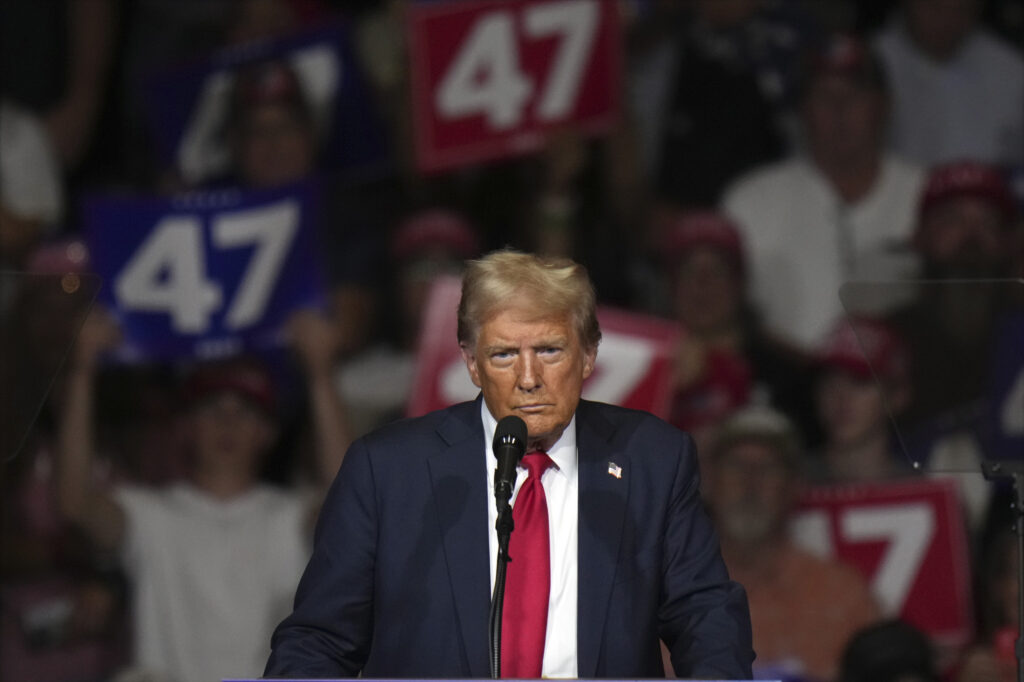With the presidency on the line in battlegrounds like Wisconsin and Pennsylvania, why would Donald Trump venture into California, one of the most solidly Democratic states, just weeks before Election Day?
Trump is almost certain to lose California, and that won’t change after his scheduled Saturday stop in Coachella, a desert city east of Los Angeles best known for the annual music festival bearing its name. Still, there are practical reasons for him to visit, despite the Republican nominee’s prospects Nov. 5 in the most populous state.
The former president lost California in a landslide in 2020. He did get 6 million-plus votes, more than any GOP presidential candidate before, and his margins topped 70% in some rural counties that typically favor conservatives on the ballot.
That’s an enormous pool of potential volunteers to work on state races and participate in phone banks into the most contested states. And Trump is likely to draw extensive media coverage in the Los Angeles market, the second-largest in the country.
Trump is visiting Coachella in between stops in Nevada, at a roundtable in Las Vegas for Latinos earlier Saturday — where he praised Hispanics as having “such energy” — and Arizona, for a rally Sunday in Prescott Valley. He narrowly lost those two swing states to Democrat Joe Biden in 2020.
Attendees waiting in broiling temperatures that approached 100 degrees Saturday said they didn’t expect Trump to win their state but were thrilled to see him.
“It’s like a convention of like-minded people,” Tom Gibbons of Palm Desert, who’s backed Trump since 2016 but been unable to see him in person until Saturday, said as he stood in line at a food truck on the polo fields that will house the crowd at the Coachella event. “Everybody understands the heartbeat of America, the plight of the working man. … It’s reassuring.”
Going to California gives Trump the “ability to swoop in and leverage this big population of Trump supporters,” said Tim Lineberger, who was communications director for Trump’s 2016 campaign in Michigan and also worked in the former president’s administration. He’s “coming here and activating that.”
Lineberger recalled Californians making calls to Michigan voters in 2016 on Trump’s behalf and said the campaign’s decision to go into safe, Democratic turf at this point was “an aggressive, offensive play.”
California is also a fountain of campaign cash for both parties, and Trump will be fundraising. Photos with the former president in Coachella were priced at $25,000, which comes with special seating for two. A “VIP Experience” was priced at $5,000.
With congressional races in California in play that could determine which party controls the House, the Coachella rally “is a get-out-the-vote type of thing that motivates and energizes Republicans in California, when they are not as close to what is going on in the national campaign,” Republican consultant Tim Rosales said.
Rosales also said to look for Trump to continue his long-running spat with Democratic Gov. Gavin Newsom.
For Republicans, “It’s motivating when you can pick at California a little bit and the governor … will take the bait,” Rosales said.
Newsom on Wednesday predicted Trump would be denigrating the state at the rally, overlooking its strengths as the world’s fifth-largest economy. The governor said that for the first time in a decade, California has more Fortune 500 companies than any other state.
“You know, that’s not what Trump is going to say,” he predicted.
Jim Brulte, a former chairman of the California Republican Party, said he thinks Trump is angling for something that has eluded him in previous campaigns: winning more total votes than his Democratic opponent.
“I believe Donald Trump is coming to California because he wants to win not only in the Electoral College, but he wants to win the popular vote. There are more registered voters in California than there are residents in 46 of the other 49 states,” Brulte said.
The Trump National Golf Club Los Angeles sits on the Pacific Coast, south of the city. But Trump has long had a conflicted relationship with California, where a Republican has not carried the state since 1988 and Democrats outnumber registered Republicans by about 2-to-1.
California was home to the so-called Trump resistance during his time in office, and Trump often depicts California as representing all he sees wrong in America. As president, he called the homeless crises in Los Angeles and San Francisco disgraceful and threatened to intercede.
He is likely to spend time on Saturday linking California’s problems to Vice President Kamala Harris, the Democratic nominee and a San Francisco Bay Area native who was California’s attorney general and represented the state in the Senate.
His campaign issued a statement alleging that under Harris, “the notorious ‘California Dream’ has turned into a nightmare for everyday Americans.”
Jessica Millan Patterson, chairwoman of the state GOP, said she looked forward to hearing Trump contrast his agenda with a Democratic White House that “has left Californians less safe and with less money in their pockets.”
Republicans, she promised, “will do our part to secure a House majority.”
(AP)












One Response
Easy question, because he’s a stupid idiot